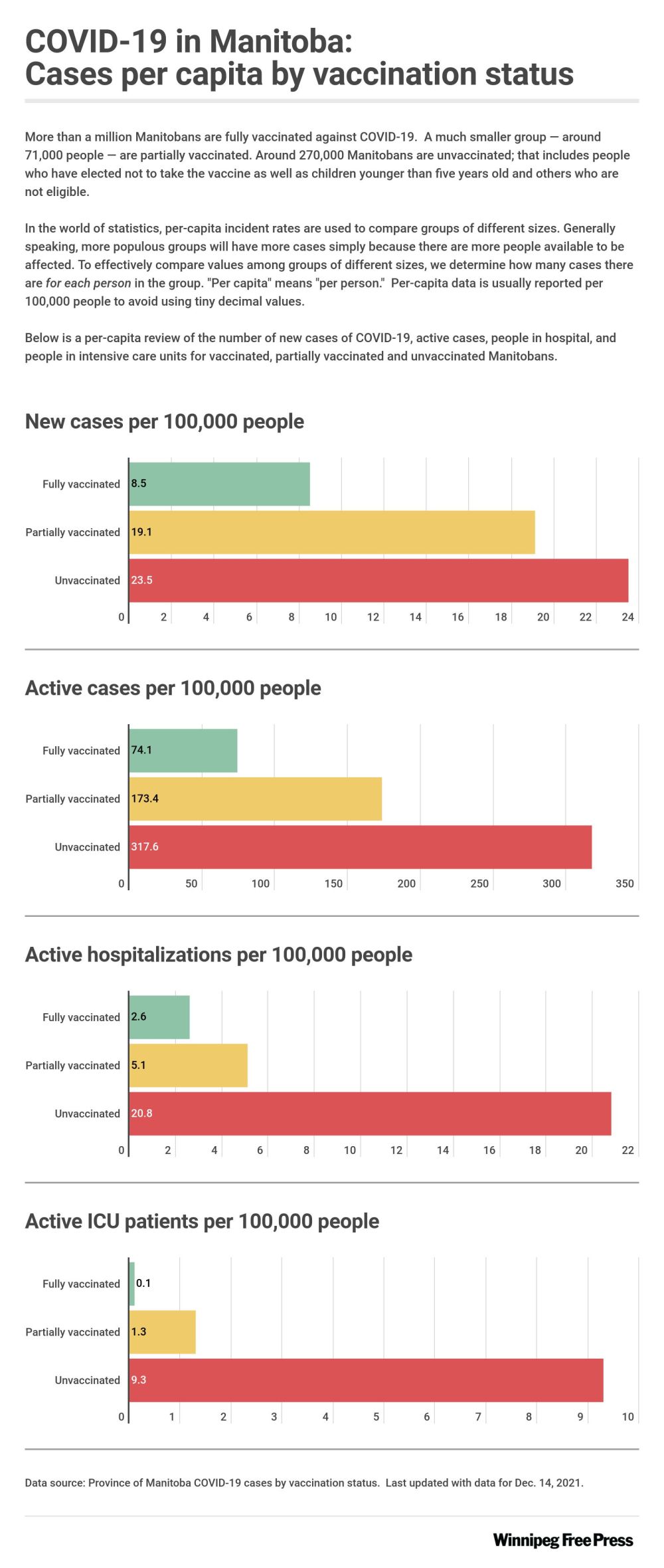‘Incomplete’ Manitoba dashboard helps fuel vax confusion: critics
Read this article for free:
or
Already have an account? Log in here »
To continue reading, please subscribe:
Monthly Digital Subscription
$0 for the first 4 weeks*
- Enjoy unlimited reading on winnipegfreepress.com
- Read the E-Edition, our digital replica newspaper
- Access News Break, our award-winning app
- Play interactive puzzles
*No charge for 4 weeks then price increases to the regular rate of $19.00 plus GST every four weeks. Offer available to new and qualified returning subscribers only. Cancel any time.
Monthly Digital Subscription
$4.75/week*
- Enjoy unlimited reading on winnipegfreepress.com
- Read the E-Edition, our digital replica newspaper
- Access News Break, our award-winning app
- Play interactive puzzles
*Billed as $19 plus GST every four weeks. Cancel any time.
To continue reading, please subscribe:
Add Free Press access to your Brandon Sun subscription for only an additional
$1 for the first 4 weeks*
*Your next subscription payment will increase by $1.00 and you will be charged $16.99 plus GST for four weeks. After four weeks, your payment will increase to $23.99 plus GST every four weeks.
Read unlimited articles for free today:
or
Already have an account? Log in here »
Hey there, time traveller!
This article was published 14/12/2021 (1459 days ago), so information in it may no longer be current.
A government dashboard showing nearly half of recent COVID-19 cases in Manitoba were among fully vaccinated people is misleading and fails to clearly represent the risk the disease poses to people who have yet to take the jab, experts say.
Manitoba public health discloses the number of new COVID-19 cases, hospitalizations and intensive care admissions by vaccination status on its pandemic dashboard each weekday.
According to the dashboard, 48 per cent of COVID-19 cases reported in the past two weeks were in fully vaccinated people and 44 per cent were in unvaccinated people. Meanwhile, on Tuesday, the province reported 88 new cases in fully vaccinated people and 61 cases in unvaccinated people.
The snapshot of daily data has since been shared on various social media channels and in anti-vaccination circles to cast doubt on the efficacy of COVID-19 vaccines.

University of Saskatchewan community health Prof. Nazeem Muhajarine said the Manitoba dashboard lacks basic population information that would provide crucial context for the number of infections being reported among vaccinated and unvaccinated people.
“Reporting this type of incomplete information in the midst of a pandemic and in the midst of one of the most highly mutated variants, omicron, knocking about… is actually very alarming,” Muhajarine said in an interview with the Free Press.
The epidemiologist described the province’s dashboard as misleading, adding it can serve as evidence and ammunition for people who already believe vaccines are not going to protect against COVID-19.
“It really does send the wrong message and signal to people who might be looking for something like this,” Muhajarine said. “They will latch on to it, harp on it and basically hold this up as confirmation of what they had always been saying, of course, erroneously.”
When adjusted to account for population size, the risk of infection for unvaccinated people in the province is more than five times greater than vaccinated people, according to Doctors Manitoba.
People who have yet to be vaccinated are also 8.4 times more likely to be hospitalized with COVID-19 and 19 times more likely to end up in intensive care, the local physicians association said.

Nearly three-quarters of all Manitobans have been fully vaccinated. Meanwhile, just under 20 per cent of residents, including those who are ineligible, have had zero doses of the vaccine.
In recent weeks, Doctors Manitoba has taken to social media to dispel misinformation and answer questions stemming from the numbers presented on the government dashboard.
“When it comes to sharing new COVID-19 cases or severe outcomes by vaccination status, it is important to present this information in a way that allows an apples-to-apples comparison,” Doctors Manitoba spokesman Keir Johnson said in a statement to the Free Press. The advocacy association has also suggested to the government it change the way it reports cases by vaccination status.
“Because the number of people who are fully vaccinated is so much larger than the number of people who are unvaccinated, it makes comparing numbers misleading unless they are presented with additional information, such as a rate or relative risk.”
Local actuary Todd Friesen has also taken on the job of adding context, using Twitter to share information about the risk and infection rate for people who are not vaccinated against COVID-19.
Friesen, a fellow with the Canadian Institute of Actuaries who has practised in Winnipeg for more than a decade, said he began sharing his analysis in an effort to support the vaccine campaign.
“If you don’t provide the context on these types of pie charts, then you run the risk of them being misused by the public and social media,” Friesen said.
“We need to do some minimal steps there to contextualise the data and to make sure that we are communicating the actual relative risk between those who are vaccinated and unvaccinated.”
In addition to including infection and hospitalization risk adjusted for population, Friesen said the province should also include risk adjustments based on age — because older people have a higher chance of experiencing a severe outcome related to COVID-19.
Friesen said the average age of unvaccinated people in Manitoba is about 20, compared to 45 for people who have been vaccinated.
“One thing that’s contributing to that is we have a large cohort of ineligible kids who are not vaccinated,” Friesen said. “What ends up happening is we’re implicitly comparing unvaccinated kids with seniors who are fully vaccinated.
“And the relative risks between seniors and kids are not remotely close.”
When adjusted for age, unvaccinated people are 45 times more likely to need hospitalization related to COVID-19 and 85 times more likely to need ICU admission, Friesen said.
“Those are substantial numbers,” Friesen said. “It shows very clearly how effective vaccines are.”
A request for an interview with a member of the provincial public health unit was not accommodated Tuesday.
In a statement, a spokesperson for the government said the data shared online is regularly reviewed.
“If the province makes a change in this reporting it will be announced,” the statement said.
danielle.dasilva@freepress.mb.ca

Our newsroom depends on a growing audience of readers to power our journalism. If you are not a paid reader, please consider becoming a subscriber.
Our newsroom depends on its audience of readers to power our journalism. Thank you for your support.






